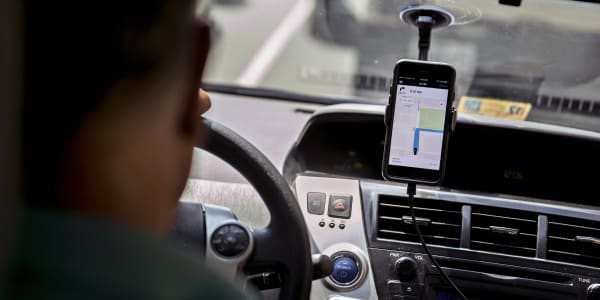


CES Unveiled was one of a host of Monday night events that officially kicked off the Las Vegas show. If the vast array of product reveal any one big theme, it's that consumer technology is in a transitional period, said longtime CES watchers.
"One of the themes is just the changing of the guard in the consumer electronics world," said Drexel Hamilton analyst Brian White. "We're at an inflection point in consumer electronics, and the stuff that drove consumer electronics in the past will decline."
In 2016 mobile devices, TVs, laptops and desktops will account for 51 percent of the industry's $287 billion in revenue, but new technology will continue to take a growing share of the market, Consumer Technology Association said in a Monday night presentation. "The catalysts for industry growth are newer innovations such as wearables, virtual reality and drones."
The "Internet of Things" will be a huge growth driver for those products, but don't expect to see entirely new categories at this year's CES. "This year is more about evolution than revolution," said Gartner analyst Brian Blau. "People have seen a lot of these in earlier forms, probably less functional, but what we're seeing now is a real uptick in terms of functionality."
One example: Home monitoring start-up Blink, which aims to compete with Alphabet's Nest Cam. The base product is less expensive — it also features a lower-quality camera — and unlike Nest and others in this category, the company isn't charging users for cloud hosting. The cameras run on AA batteries, which the company says will last up to a year. Launched as a Kickstarter project in 2014, they are now shipping starting at $109 for a one-camera system, up to $229 for a multiroom set."
However futuristic and "cool" many of the products may be, this year many are selling themselves on their health and safety benefits. "Cool is great, but that's only for early adopters," said Blau. "None of these companies can survive unless they sell their product en masse. There will be a few winners that don't require that because they're so cool, but for most they've really got to show a lot of value," he said.
Vert — a small black sensor that can be attached to a waistband — is a jump-monitoring wearable for athletes. It sends workout data — i.e jump count and intensity, G-force, surge count — to an app.
"Unlike a lot of wearable products that count steps and people use for 90 days and then put in a drawer, our product people continue to use [Vert] because it's about injury prevention," said founder Martin Matak.
The other thing that sets the product apart is its business model. The wearable costs $125, and the company licenses its monitoring and analytics software for tens of thousands, said Matak. Vert has partnerships with the USA Volleyball team, the National Collegiate Athletic Association and ESPN, which incorporate its products and data into live coverage.
Another start-up gaining a lot of attention is Digitsole, a smart footware maker. The aptly named Smartshoe features an integrated heating system, motion tracking, wireless charging, shock absorption measurement and, yes, automatic shoe lacing. It's connected to a user's phone via Bluetooth and controlled via an app.
It comes in three styles, including a women's pump and sneaker, which will retail at $350 when the new products go on sale in the fall. That may seem steep for a plain-looking pair of pumps, but the shoes are not aimed at everyone. "This product is for tech savvy people, early adopters," said Tamim el Zein, director of business development.
Zein said the shoes bring together much of the same functionality as wristbands or watches, with much greater accuracy when it comes to step counting.
The company also unveiled an update to its Warm Series — the Digitsole — a connected and interactive heating insole. An app lets users control the temperature of the insole and track physical activity such as steps, distance and calories. The insoles fit most shoes, charge in less than two hours and the battery life lasts for 24 hours. The insoles cost of $199 on Amazon and are already available in 30 countries.
Trackers of all shapes and sizes are definitely a thing.
Run Rockets are sensors that attach to shoes or skis to analyze a user's running or skiing form in real time. Feedback is delivered via a heads-up display that looks like a cross between a Google Glass and a pair of sunglasses. A set costs between $350 and $550. CEO Hermann Schindler is looking for investors in order to sell the product, developed in Europe, in the U.S.
Ski tech seems to be a trend. In&motion is showing off what it's calling the world's first smart ski airbag vest. Worn under a ski suit, sensors in the vest can detect an unrecoverable imbalance, anticipate an impact and inflate, all in less than a tenth of a second. Approved by the International Ski Federation, it was worn by cross racers in 2015 and will be in stores in time in the 2016-17 ski season.
Wearable bands, however, are not going away, and they are getting more fashionable and offering new functionality.
Gemio's smart friendship bracelets start at $100 and are aimed at teens. The bands contain 20 RGB LEDs that backlight gemsets that can be switched out to match the wearer's mood. Users can pair their bracelet with friends, then send light messages via agreed upon signals or text messages via an app. Like ringtones, users can assign personalized light patterns to each friend, which light up when they are within 50-100 feet. "Stealth mode" offers the ability to interact via vibrations.
The band can also be programmed to trigger specific light patterns based on gestures, such as a wave, high-five or a flick of the wrist. Users can also change the color of the gems back-lighting by pointing its sensor at an item whose hue they want to match. A built-in mic will listen to music and flash lights to the beat. It's powered wirelessly and can be paired with an app.
While tech giants are focused on connecting the home, start-ups are creating devices that will make those ecosystems more useful.
OneCook is branding itself as the world's first robotic personal chef. The device looks like a pressure cooker and uses patented technology combined with an online ingredient delivery platform to prepare meals. The goal is to allow users to be health conscious without really having to think about it.
Kickstarter has changed the game when it comes to launching hardware products, and a number of those companies are at CES this year; GoSun is one example. The futuristic-looking clean grill — which is charcoal and propane free — can cook a meal in under an hour for up to eight people, day or night. It uses vacuum tube insulation technology developed by founder Patrick Sherwin, who took solar water-heating technology to grilling.
The start-up raised half a million dollars to build a solar-powered grill, then secured a grant from the United Nations thanks to its mission to bring clean cooking to countries such as India, Nepal and Guatemala. "Almost half the world is cooking on fuels that are harmful to their health," Sherwin said.
The company was founded as a double bottom line business, meaning its business model uses sales of the GoSun Stove to subsidize the GoSun Global, which the company sells in developing countries.
Hoverboards may be banned from the showfloor this year, but electronic things on wheels are trending.
On Wednesday, Xiaomi-backed Ninebot, the owner of Segway, is set to launch a new mystery product.
ACTON, the creators of RocketSkates (which it says are the world's first smart electric skates) and the M-scooter (a motorized scooter), on Tuesday unveiled the Blink Board, a wireless, Bluetooth-controlled skateboard. As with ACTON's other devices, it comes with an app to regulate performance, record data and connect with other users.
The goal of the San Francisco-based company is a lofty one: "To create exhilarating small transportation for the entire world to zip around on.
Moving back up the transport chain, Arcimoto is showing off its speedy three-wheeled electric cart.
In traditional CES fashion, there are of course some products here whose goal appears less lofty. This year VR and VR accessories are everywhere.
"When you put a VR headset on, you want to see your hands and do things with your hands, the next thing you want to do is move," says Stan Chesnais, CEO and co-founder of 3Drudder, a foot-based 3D navigation and motion system. The red disc which attaches to the user's feet and works with the Oculus Rift. "It enables you to move, even fly in VR," says Chesnais.
But is it just a gimmick?
"At CES everything is a gimmick until it's a thing," said Blau.







